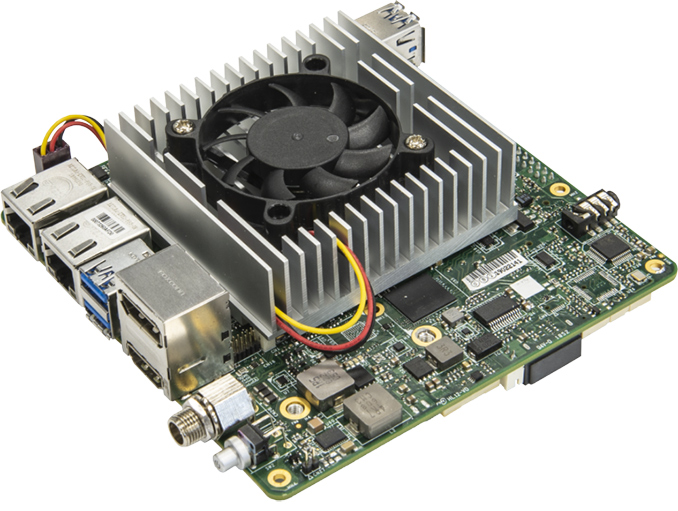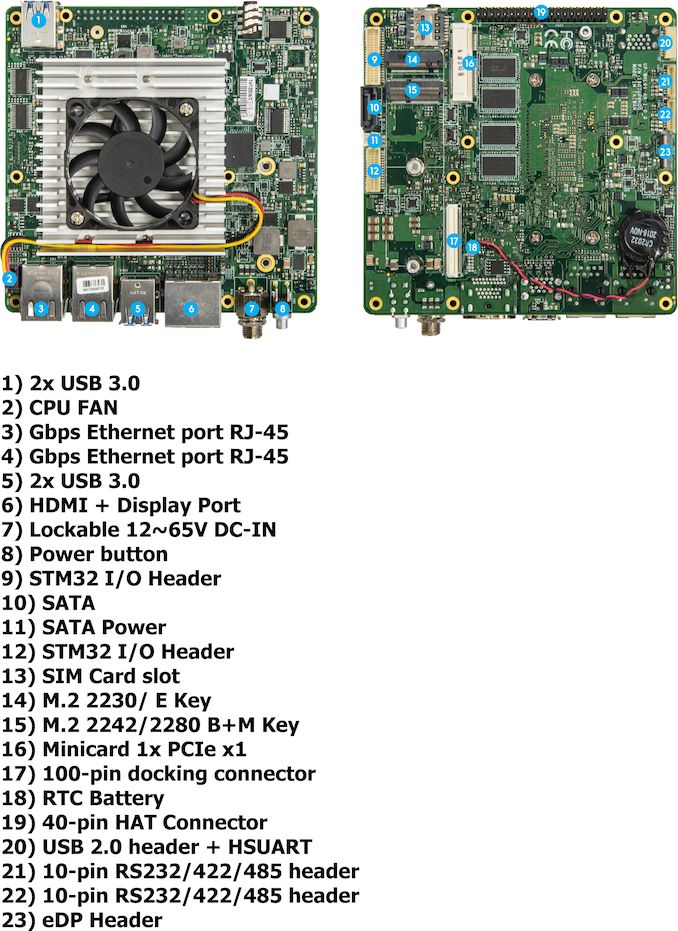AAEON's UP Xtreme: A Mini-Single Board Computer with Intel's Whiskey Lake
by Anton Shilov on March 27, 2019 12:00 PM EST- Posted in
- Motherboards
- Intel
- UCFF
- Whiskey Lake
- AAEON

AAEON has introduced its new single board computer (SBC) that is powered by Intel’s Core i3/i5/i7 ‘Whiskey Lake’ SoCs. The AAEON UP Xtreme is designed for developers of embedded applications that need performance of Intel’s higher-end CPU cores in a very small form-factor. The SBC comes with a BGA SOC, soldered-down DDR4 memory, eMMC storage, and has a rich set of I/O connectors.
Traditionally, AAEON’s UP-series single board computers have used Intel’s low-power Atom-class SoCs (Cherry Trail, Apollo Lake, etc.). As the name suggests, the UP Xtreme SBC is aimed at embedded devices that need Intel’s high-performance mobile SoCs, such as dual-core or quad-core Whiskey Lake processors with Intel’s UHD Graphics 620, and a 15 W TDP. Just like other SBCs, the UP Xtreme measures 120x120 mm, but because of increased TDP it uses active cooling. Depending on exact SKU, the UP Xtreme comes with 4 to 16 GB of DDR4 memory as well as 16 to 128 GB of eMMC 5.1 storage.
The motherboard carries two GbE controllers from Intel (i210/i211, and i219LM PHYs), four USB 3.0 ports, two USB 2.0 ports, two Serial ports controlled using the Fintech F81801 chip, display outputs (DisplayPort, HDMI, eDP), RealTek’s ALC887 audio codec, and so on. As for expandability, the UP Xtreme SBC has a SATA connector, an M.2-2280 slot (PCIe 3.0 x2, SATA), an M.2-2230 slot, a 40-pin HAT connector, a 100-pin docking connector, and so on.
Because of rich connectivity options supported by the UP Xtreme motherboard, it may not only address a vast range of embedded systems, but can also be paired with various custom-designed modules (i.e., AAEON’s AI Module, Intel’s RealSense cameras, etc.) for emerging applications that need computer vision, AI, and so on. Meanwhile, the SBC is compatible with Android, Windows 10, Ubuntu, and Yocto operating systems.
AAEON has not disclosed pricing of its UP Xtreme single board computers, but given the fact that Intel’s Whiskey Lake processors start at $281 in sets of 1000, do not expect these products to be cheap even in entry-level configurations.
Related Reading:
- Intel Launches Whiskey Lake-U and Amber Lake-Y: New MacBook CPUs?
- Spectre and Meltdown in Hardware: Intel Clarifies Whiskey Lake and Amber Lake
- Cincoze DX-1100 Ultra Compact Rugged System: Xeon-E with Custom I/O Expansion
- iBASE Launches MI995 Mini-ITX Intel CM246-Based Board for Xeon E
- ASRock Launches C246M WS Micro-ATX Motherboard for Xeon E CPUs
Source: AAEON (via CNX Software)












12 Comments
View All Comments
shaonadnan - Monday, April 27, 2020 - link
follow this blog for gaming requirements<a href="https://systemsrequirement.com/albion-online-syste... Online System Requirements</a>
shaonadnan - Monday, April 27, 2020 - link
https://systemsrequirement.com/albion-online-syste...